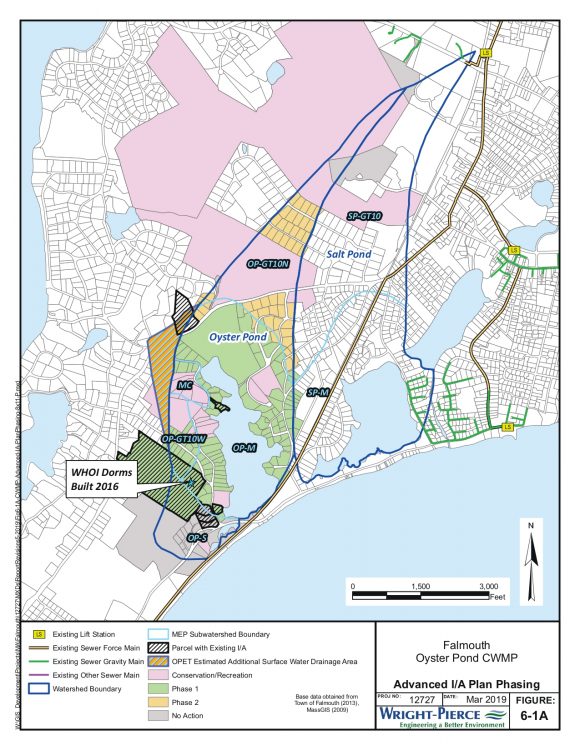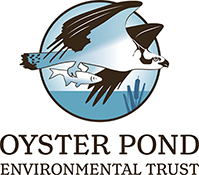Last August the WQMC held a meeting for Oyster Pond residents and discussed two options for cleaning up Oyster Pond. Plan 1 required 189 dwelling units around the pond connect to low-pressure collection sewers. Plan 5 required 226 dwelling units to upgrade to an Advanced Innovative/Alternative septic system.

Plan 5, the Advanced I/A plan, will be implemented in two phases. Phase 1 is the green colored area and the start date would be in 2025. If needed, Phase 2, which includes the yellow colored parcels, would start in 2040.
The WCMC has now elected to proceed for now with Plan 5, while Plan 1 will become the Traditional Backup Plan. In 2024, the Town will reevaluate both plans and make a final determination as to the best plan to implement. There are still many unanswered questions and uncertainties that must be addressed in both plans. The WQMC will spend the next five years investigating these issues.
Plan 5, the Advanced I/A plan, will be implemented in two phases. Phase 1 is the green colored area and the start date would be in 2025. If needed, Phase 2, which includes the yellow colored parcels, would start in 2040.
The cost to homeowners was updated with new information and assumptions. The cost for the sewering plan per household is estimated to be $4,080 annually. Under the Advanced I/A the costs range from $4,030 to $5,080 per year depending the frequency of inspections of the system that might be needed or available interest rates.
Wright-Pierce, the consultant for the Town, presented the update on the Oyster Pond Comprehensive Wastewater Management Plan (CWMP) at an August meeting of the WQMC. A copy of the power point presentation is here along with an article in the Falmouth Enterprise about the meeting. You can also watch a video of the meeting on the FCTV web site.
You can read the updated July 2019 CWMP here. It is an extremely large document. The parts to focus on are the new maps and information in Section 5 for Plans 1 (pages 5-4 and 5-5) and Plan 5 (5-12 and 5-13) and the updated costs of each plan on Table 5-7 (page 5-18) and Table 5-8 (page 5-22). It is also worth reading the new Section 6, the Implementation Plan that explains the timeline of the plan. Section 7 is an Evaluation of Environmental Impacts. Appendix F contains more details about how the Advanced I/A Plan will be implemented (page 325).
If implemented, the Advanced Innovative/Alternative Plan will be conducted in two phases. Phase 1 will require the 189 dwelling units closest to the pond to upgrade their septic system. The Town will continue to monitor and assess the effectiveness of Phase 1 for improving the condition of the pond. If Phase 1 is working, but additional nitrogen must be removed, then Phase 2 will move forward and require the remaining 44 homes also upgrade to Advanced I/As. It is estimated Phase 2 will not occur until the year 2040.
Once a Start Date is set for implementing Phase 1 of the Advanced I/A plan, homeowners have one year to obtain a permit to install the new system and three years to complete the work. They must also grant the right for the Town or a designee to access their property to periodically inspect and test the septic system. The costs for implementing the plan will be split between the Town and the homeowner. The Town will supply the physical components of the Advanced I/A system while the property owner will be responsible for the site engineering plans, permitting costs, Title 5 system components plus installation and landscaping expenses. Additionally, they must pay a semi-annual fee for the costs of testing and monitoring their systems.
If the sewering Traditional Backup Plan is selected 189 dwelling units will be connected to a low pressure sewer system. This type of sewering system will require a low-pressure lift station at each residence. The effluent will be sent to the Blacksmith Shop Road Wastewater treatment facility.
This plan is needed because there is too much nitrogen in Oyster Pond. The high nitrogen levels are from too many conventional septic systems in the watershed. Existing Title V septic systems are great at removing pathogens from entering groundwater, but not nitrogen. Just as nitrogen feeds your garden plants, it also feeds the plants or algae in the pond. Too much nitrogen along with low salinity levels in the pond caused the algal bloom in the summer of 2016. Removing this pollution source will be the key to restoring Oyster Pond to a healthier ecosystem.
Oyster Pond is one of fifteen estuaries in Falmouth degraded due to too much nitrogen. The Town of Falmouth is mandated to reduce this nitrogen entering the estuaries by the Clean Water Act of 1973. It is working with consultants to develop Comprehensive Wastewater Management Plans (CWMP) for each of these impacted water bodies.

